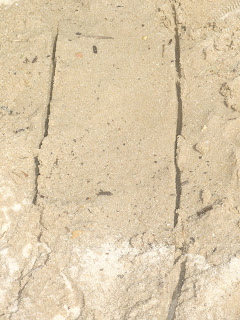
It began with a child (A) using a truck roller on the edge of the sandpit. He then stood back to admire the path he had made. This drew the attention of another child (B) who had been watching the roller out of the corner of his eye. I could see B really wanted to use the roller and was waiting patiently for his turn, I approached B and initiated a conversation which lead to the two of us looking for other equipment they could use as a roller.
We returned with a cardboard tube. I could see B was using all of his resilience skills to accept the new prop. He made several comments about it not being the same and being to big, so we went exploring again. This time joined by several other children.
 Finding smaller plastic items that were still covered in the previous evenings dew, we returned to the sandpit and began our rolling.
Finding smaller plastic items that were still covered in the previous evenings dew, we returned to the sandpit and began our rolling. As the children applied the items various patterns then appeared lightly in the sand. This was pointed out to the children who became quite excited and then began using several others types of rollers to make more tracks.
One of the children voiced his frustrations when his tracks disappeared as he walked over them.

I reflected on how I could support this experience further, and enhance their learning without taking over. With the intention of making the sand a little more stable so the tracks would become more visible, I added a watering can, full of water, to the sandpit. The children began rolling over the wet sand and excitedly looked back at the marks made "That's like a train's track" said C, "No, more like a road, see this is the line in the middle" said B, as he noticed that two rollers had been used together, leaving a very unique impression in the sand.
The children used the watering can to add even more water to the sandpit and see what various tracks they could create.
When all the watering cans were being used child D decided to take his roller to the water source, to wash the sand off and bring back drips of water.
Throughout this learning opportunity I discussed simple mathematical concepts with the children, such as - counting, depth and volume as further opportunities arose. The children in turn explored these concepts, pushing their rollers deeper into the sand, measuring the length and width of tracks with their hands or feet.
A small group then experimented with the rollers on the grass areas and footpaths but returned to the sand stating the tracks were easier to see.






